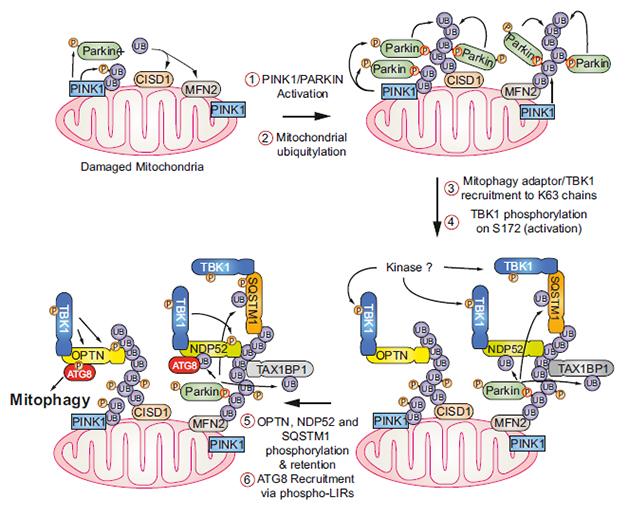ALS-Linked Kinase Promotes Mitochondrial Destruction
Quick Links
Genes involved in Parkinson’s disease and amyotrophic lateral sclerosis are emerging as ever more entwined thanks to their key roles in the disposal of damaged or old mitochondria. In August, researchers led by Richard Youle at the National Institute of Neurological Disorders and Stroke in Bethesda, Maryland, delineated how the familial PD genes PINK1 and Parkin work upstream of the ALS genes Optineurin and TBK1 in the disposal process called mitophagy (see Sep 2015 news). Now, reporting in Molecular Cell online September 10, Wade Harper and colleagues at Harvard Medical School flesh out how the kinase TBK1 tightens the bonds between ubiquitin chains on the mitochondrial surface and either Optineurin or another mitophagy protein, NDP52. Strengthening those ties promotes mitophagy, the scientists report.

Disposal brigade. Ubiquitin chains on ailing mitochondria recruit a collection of mitophagy mediators starting with PINK1 and Parkin, then adaptor proteins such as Optineurin and its partner TBK1. [Image courtesy of Molecular Cell, Heo et al.]
Research suggests that stressed mitochondria call in Parkin and PINK1, which add ubiquitin molecules and phosphate groups to the damaged organelles. The ubiquitin chains then recruit autophagy receptors such as NDP52 and Optineurin, which recruit the full autophagy apparatus. Without TBK1, which activates Optineurin by phosphorylating it, mitophagy does not proceed.
Now, first author Jin-Mi Heo and colleagues reveal why mitophagy stalls without TBK1. They found that in HeLa cells, Optineurin and TBK1 bind in the cytoplasm and that when Optineurin finds a ubiquitin chain on a damaged mitochondrion, it takes hold of that chain, but loosely, pulling TBKI along. Once the complex attaches to the organelle, an as-yet-unknown kinase phosphorylates TBK1, activating it. The active TBK1 then phosphorylates two sites in Optineurin’s ubiquitin-binding domain, increasing its grip on the mitochondria. Now firmly attached to the organelle, Optineurin recruits the autophagy machinery.
Moreover, the researchers found evidence that TBK1 binds and phosphorylates NDP52, too, though they have not confirmed the specific amino acids that TBK1 modifies. Study co-author Alban Ordureau suspects those two cooperate in a similar manner to TBK1 and Optineurin to promote autophagy.
Ordureau and Heo pointed out they also disagree with some findings from the August report. While Youle and colleagues suggested Parkin was dispensable for mitophagy, Harper and colleagues determined the organelles were unable to recruit Optineurin and TBK1 without Parkin. They also posit that while phosphorylation of ubiquitin chains recruits Parkin, Optineurin and NDP52 can interact with unphosphorylated chains.—Amber Dance
References
News Citations
External Citations
Further Reading
Papers
- Kane LA, Lazarou M, Fogel AI, Li Y, Yamano K, Sarraf SA, Banerjee S, Youle RJ. PINK1 phosphorylates ubiquitin to activate Parkin E3 ubiquitin ligase activity. J Cell Biol. 2014 Apr 28;205(2):143-53. Epub 2014 Apr 21 PubMed.
- Kazlauskaite A, Kondapalli C, Gourlay R, Campbell DG, Ritorto MS, Hofmann K, Alessi DR, Knebel A, Trost M, Muqit MM. Parkin is activated by PINK1-dependent phosphorylation of ubiquitin at Ser65. Biochem J. 2014 May 15;460(1):127-39. PubMed.
- Shiba-Fukushima K, Arano T, Matsumoto G, Inoshita T, Yoshida S, Ishihama Y, Ryu KY, Nukina N, Hattori N, Imai Y. Phosphorylation of mitochondrial polyubiquitin by PINK1 promotes Parkin mitochondrial tethering. PLoS Genet. 2014 Dec;10(12):e1004861. Epub 2014 Dec 4 PubMed.
- Wong YC, Holzbaur EL. Optineurin is an autophagy receptor for damaged mitochondria in parkin-mediated mitophagy that is disrupted by an ALS-linked mutation. Proc Natl Acad Sci U S A. 2014 Oct 21;111(42):E4439-48. Epub 2014 Oct 7 PubMed.
- Okatsu K, Koyano F, Kimura M, Kosako H, Saeki Y, Tanaka K, Matsuda N. Phosphorylated ubiquitin chain is the genuine Parkin receptor. J Cell Biol. 2015 Apr 13;209(1):111-28. Epub 2015 Apr 6 PubMed.
- Wauer T, Swatek KN, Wagstaff JL, Gladkova C, Pruneda JN, Michel MA, Gersch M, Johnson CM, Freund SM, Komander D. Ubiquitin Ser65 phosphorylation affects ubiquitin structure, chain assembly and hydrolysis. EMBO J. 2015 Feb 3;34(3):307-25. Epub 2014 Dec 19 PubMed.
- Koyano F, Okatsu K, Kosako H, Tamura Y, Go E, Kimura M, Kimura Y, Tsuchiya H, Yoshihara H, Hirokawa T, Endo T, Fon EA, Trempe JF, Saeki Y, Tanaka K, Matsuda N. Ubiquitin is phosphorylated by PINK1 to activate parkin. Nature. 2014 Jun 5;510(7503):162-6. Epub 2014 Jun 4 PubMed.
- Pickrell AM, Huang CH, Kennedy SR, Ordureau A, Sideris DP, Hoekstra JG, Harper JW, Youle RJ. Endogenous Parkin Preserves Dopaminergic Substantia Nigral Neurons following Mitochondrial DNA Mutagenic Stress. Neuron. 2015 Jul 15;87(2):371-81. PubMed.
News
- Juvenile Lysosomes and Worn-Out Mitochondria Clog Axons in ALS Model
- Optineurin Mutations Cause ALS, If Not Glaucoma
- Parkinsonism-linked Protein Binds Parkin and Pink1, Drives Mitophagy
- TANK-Binding Kinase 1 Rumbles in as New ALS Gene
- Abnormal Mitochondrial Dynamics—Early Event in AD, PD?
- Second Study Salutes TANK-Binding Kinase 1 as ALS Gene
- ALS, Parkinson’s Proteins Co-Mingle in Mitochondria Destruction Pathway
Primary Papers
- Heo JM, Ordureau A, Paulo JA, Rinehart J, Harper JW. The PINK1-PARKIN Mitochondrial Ubiquitylation Pathway Drives a Program of OPTN/NDP52 Recruitment and TBK1 Activation to Promote Mitophagy. Mol Cell. 2015 Oct 1;60(1):7-20. Epub 2015 Sep 10 PubMed.
Annotate
To make an annotation you must Login or Register.

Comments
No Available Comments
Make a Comment
To make a comment you must login or register.